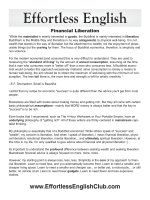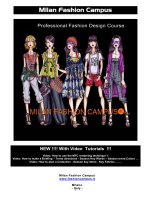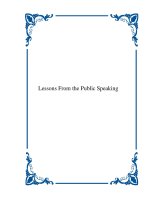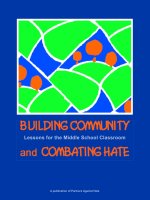Bebop l3 festival lessons
Bạn đang xem bản rút gọn của tài liệu. Xem và tải ngay bản đầy đủ của tài liệu tại đây (151.42 KB, 6 trang )
HALLOWEEN
Make the pumpkin mask. Point and say: It’s a (pumpkin). / They’re (eyes).
Key Language: eyes, mouth, nose, teeth, pumpkin, It’s a (pumpkin). / They’re (eyes).
This page has been downloaded from www.macmillanyounglearners.com/bebop © Macmillan Publishers Limited 2014
CHRISTMAS
Make the Christmas tree. Point and say: What’s this? It’s (a) (Christmas tree).
Key Language: angel, Christmas tree, star, stocking, What’s this? It’s (a) (Christmas tree).
This page has been downloaded from www.macmillanyounglearners.com/bebop © Macmillan Publishers Limited 2014
ST. PATRICK’S DAY
Make a filter paper shamrock. Color it green. Say: Happy St. Patrick’s Day!
Key Language: Ireland, shamrock, Happy St. Patrick’s Day!
This page has been downloaded from www.macmillanyounglearners.com/bebop © Macmillan Publishers Limited 2014
HALLOWEEN
TEACHER’S NOTES
Lesson Objectives
·· learn about Halloween
·· learn Halloween and parts of the face vocabulary
·· make a pumpkin mask
·· strengthen fine motor skills
Key Language
·· eyes, mouth, nose, teeth, pumpkin, It’s a (pumpkin). / They’re (eyes).
Further Language
·· arms, feet, hands, head, legs
Materials
card stock paper, carved pumpkin (or picture of a carved pumpkin), orange paint, black
construction paper, sticky tape, popsicle sticks
Preparation
Before the lesson, print one Halloween template page for each child, and glue it onto the
card stock paper. Prepare the carved pumpkin or the picture of the carved pumpkin.
Lesson Notes
Show the children the Halloween pumpkin. Point to the pumpkin and say pumpkin. Ask the
children to repeat. Then point to the pumpkin’s eyes and ask What’re these? Elicit the word
eyes, then say They’re eyes, and ask the children to repeat. Do the same with teeth. Point
to the pumpkin’s nose and ask What’s this? Elicit the word nose, then say It’s a nose, and
ask the children to repeat. Do the same with mouth. Then point to the pumpkin again and
ask What’s this? Encourage the children to answer It’s a pumpkin.
Give the children the Halloween template, and ask them to cut out the pumpkin – they
will need help to cut out the eyes. Ask the children to paint their pumpkins orange. Show
them how to make a nose, mouth, and teeth by cutting shapes from black construction
paper. When the painted pumpkins are dry, glue the facial features onto the pumpkin.
Secure a popsicle stick to the back of each pumpkin with sticky tape to make a mask that
the children can hold in front of their faces.
At the end of the lesson, point to different features on the children’s masks and ask
What’s this? / What’re these? Encourage the children to answer using the correct structure
It’s a (nose). / They’re (eyes).
Further Language Practice
Extend vocabulary practice and understanding of the language structures. Show a
picture of a Halloween monster, and point to the head, legs, arms, hands, and feet. Ask
What’s this? / What’re these?
This page has been downloaded from www.macmillanyounglearners.com/bebop © Macmillan Publishers Limited 2014
CHRISTMAS
TEACHER’S NOTES
Lesson Objectives
·· learn about Christmas
·· learn Christmas vocabulary
·· make a Christmas tree
·· strengthen fine and gross motor skills
Key Language
·· angel, Christmas tree, star, stocking, What’s this? It’s (a) (Christmas) tree.
Further Language
·· gingerbread house, lights, tinsel
Materials
card stock paper; green paint; picture of a Christmas tree; large pictures or ornaments of
an angel, a star, and a stocking; colored paper; shiny paper
Preparation
Before the lesson, print one Christmas template page for each child, glue it onto the card
stock paper, and prepare the paint.
Lesson Notes
Show the children a picture of a Christmas tree, and ask them if they can say what it is in
English. Say Christmas tree, and ask them to repeat. Show the children a star, a stocking,
and an angel. Point and say star, and ask the children to repeat. Continue with the other
Christmas decorations.
Give each child the Christmas template. Ask the children to cut out the Christmas trees
and cut along the dashed line inside each tree. Have the children paint their trees green.
Give the children the colored paper and the shiny paper, and ask them to draw and cut out
angels, stars, and stockings to decorate their trees. When the trees have dried, show the
children how to slot the two trees together to create one three-dimensional tree. Allow the
children to decorate their trees with their decorations.
At the end of the lesson, point to different trees and decorations and ask What’s this?
Encourage children to reply It’s (a) (star). / It’s (an) (angel). Say What’s this? again and clap
your hands on each syllable. Ask the children to say What’s this? with you, and encourage
them to clap their hands, too. Then ask the children to show their Christmas trees to a friend.
Have the children practice asking What’s this? and answering It’s (a) (star). / It’s (an) (angel).
Further Language Practice
Teach the children the names of other Christmas decorations or symbols, such as tinsel, a
gingerbread house, and lights.
This page has been downloaded from www.macmillanyounglearners.com/bebop © Macmillan Publishers Limited 2014
ST. PATRICK’S DAY
TEACHER’S NOTES
Lesson Objectives
·· learn about St. Patrick’s Day and talk about celebrations in different countries
·· make a shamrock
·· learn that mixing blue and yellow makes green
·· strengthen fine and gross motor skills
Key Language
·· Ireland, shamrock, Happy St. Patrick’s Day!
Further Language
·· gold, leprechaun, rainbow
Materials
card stock paper; world globe; pictures of a St. Patrick’s Day parade, Irish dancing, and
a shamrock; coffee filter paper; newspaper; yellow and blue food coloring, spray bottle
filled with water; droppers or drinking straws
Preparation
Before the lesson, print one St. Patrick’s Day template page for each child, glue each
template onto the stiff card stock paper, and cut out the shamrock. You could ask the
children to wear green for the day, play Irish music, and even try some Irish dances.
Lesson Notes
Show the children a globe and point to their country. Then show them Ireland. Point and say
Ireland, and ask the children to repeat. Ask the children how far away they think Ireland is and
how they might travel there. Say that St. Patrick’s Day is an Irish celebration, and show pictures
of a St. Patrick’s Day parade and an Irish dance. Ask them to compare this festival to a festival
celebrated in their country. Say Happy St. Patrick’s Day! and stomp your feet on each syllable.
Ask the children to say it with you, and encourage them to stomp their feet, too. Show the
children the picture of a green shamrock, and explain that the shamrock is a symbol of Ireland,
which is why many people wear green on St. Patrick’s Day. Point and say shamrock, and ask the
children to repeat.
Give each child a pre-prepared shamrock template. Ask them to draw around it on coffee
filter paper, and then cut it out. Help the children place their coffee filter shamrocks on
newspaper and squirt a few drops of the yellow and blue food coloring on them using a dropper
or drinking straw. Then squirt the paper with water, and show the children how the colors blend
to make different shades of green.
At the end of the lesson, have a St. Patrick’s Day parade and shout out Happy St. Patrick’s Day!
Further Language Practice
Tell the children about Irish leprechauns. Leprechauns are mischievous little fairy men
dressed in green clothing. If a leprechaun finds his way into a house, he might turn chairs
upside down or hide toys! It is said that every leprechaun has a pot of gold hidden at the
end of a rainbow.
This page has been downloaded from www.macmillanyounglearners.com/bebop © Macmillan Publishers Limited 2014









